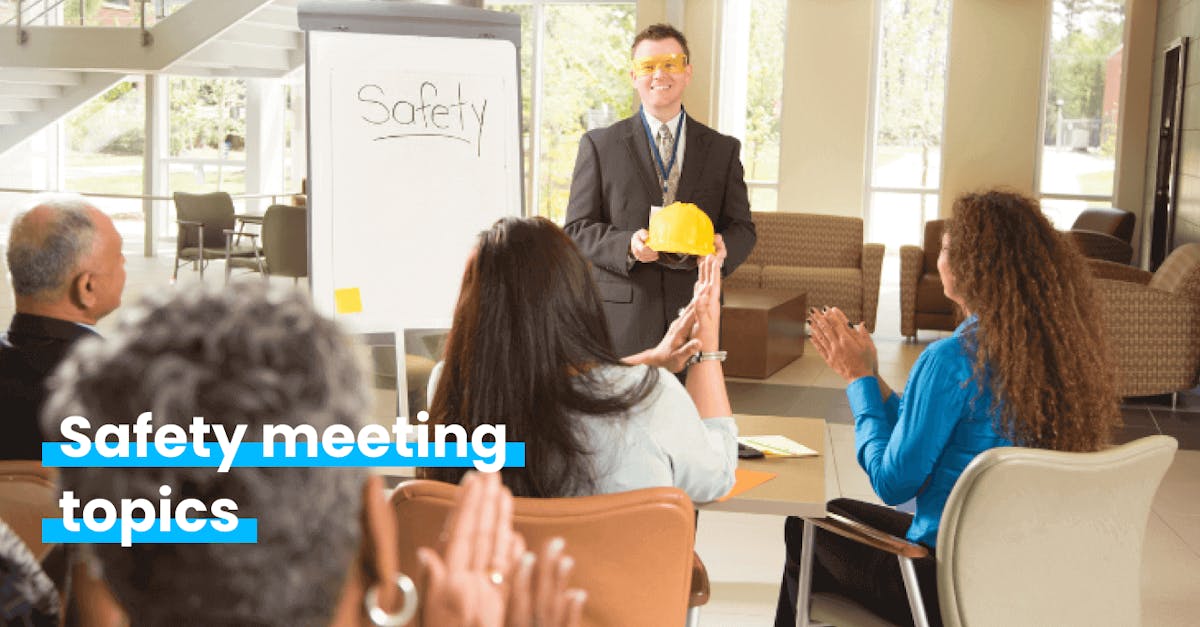8 Safety meeting topics every employer should cover

Conducting a safety meeting is essential to any company that values its employees’ health, well-being, and security. After all, the foundation of every organization’s success starts with its people.
As an employer, it’s your duty to remind your employees of the dos and don’ts of maintaining a healthy working environment. You need to give them the understanding they need to identify and handle potential dangers in the workplace.
In this article, we’ve listed eight safety meeting topics you can share during your team huddles. But before we dive into the list, let’s explore the details of how safety meetings are necessary in the workplace.
The importance of workplace safety meetings
Here are some key reasons why workplace safety meetings are important:
- Awareness: Safety meetings help raise awareness among your employees about workplace hazards. They’ll be able to recognize and understand the risks they may face on the job.
- Education: You can consider these meetings as a platform for you to educate your crew on safety protocols, procedures, and best practices, so they have the knowledge and skills needed to work safely.
- Prevention: By discussing past incidents, near misses, and lessons learned, you can develop strategies to prevent accidents and injuries in the future.
- Compliance: With regular safety meetings, you can make sure your employees are aware of and comply with relevant safety regulations, standards, and legal requirements.
- Communication: Workplace safety meetings facilitate open communication channels, which allow your employees to express their concerns, suggestions, and ideas related to safety.
- Injury reduction: Addressing safety concerns raised during meetings and implementing preventive measures means you actively contribute to reducing the number of workplace injuries and the related costs.
- Organizational reputation: Demonstrating your commitment to workplace safety attracts and retains talented employees and customers who value a safe working environment.
Safety meeting topic #1 - Workplace violence and harassment prevention
Violence and harassment in the workplace are often overlooked and ignored, despite being serious issues that can have severe physical and psychological effects on employees. In a global survey by the International Labour Organization (ILO), 17.9% of employed men and women reported experiencing psychological violence and harassment in their working lives.

This is when toolbox talks come in handy. You can discuss with your team how to detect and report any form of harassment and how to protect themselves from such attempts. Involving them in these discussions can create a safer, more supportive workplace where everyone’s aware of their rights and responsibilities.
How you take measures after a safety meeting matters. Here are some ideas that you can implement to prevent violence and harassment at work:
- Review and revise workplace violence and harassment policies.
- Clearly communicate a zero-tolerance policy.
- Set up a confidential reporting system and promptly investigate all reports.
- Apply appropriate disciplinary measures against individuals found responsible for workplace violence or harassment.
- Offer counseling and assistance programs.
- Promote a respectful and inclusive work culture.
- Maintain records of incidents and actions taken.
- Conduct training on recognizing, preventing, and reporting incidents.
- Continue learning initiatives through regular refresher training sessions.
Related courses about workplace violence and harassment prevention:
- Bullying and Harassment by EdApp
- Sexual Harassment in the Workplace by EdApp
- Workplace Discrimination by EdApp
- Diversity and Inclusion by EdApp
Sign up with EdApp and explore thousands of free editable safety courses today!
Safety meeting topic #2 - Fatigue and stress management
High levels of fatigue and stress can heavily impact employee safety and health. When workers undergo extreme tiredness or weariness, they’re more likely to make mistakes and harmful decisions or get into accidents.

The same goes when they’re under stress. They may need help maintaining focus and confidence and reinforcing their commitment to performing their job. In these cases, employers should encourage their employees to take regular breaks and oversee their workload to avoid burnout.
Bringing up fatigue and stress control in your safety talk routines will do wonders for the overall atmosphere in the workplace. Cite common factors that cause these problems and come up with the necessary preventive measures.
As an employer, here are some actions you can take after a safety meeting about fatigue and stress:
- Promote the importance of good sleep, nutrition, and exercise.
- Review and adjust work schedules and workloads.
- Encourage regular breaks throughout the workday to reduce stress and recharge.
- Support work-life balance and set realistic workload expectations.
- Offer access to resources (e.g., stress management workshops, counseling services, and employee assistance programs).
- Train employees on recognizing and addressing signs of fatigue and stress, as well as taking care of mental health.
Related courses about fatigue and stress management:
- Fatigue Risk Management by EdApp
- Fighting Fatigue by EdApp
- Managing Leadership Stress by EdApp
- Mental Health in the Workplace by EdApp
- Personal and Team Resilience by EdApp
Safety meeting topic #3 - First aid for workplace emergencies
Workplace injuries aren’t an uncommon situation. In fact, every year, around 340 million occupational accidents happen, and 160 million are victims of work-related illnesses worldwide.

When accidents occur, it may take time for a fully-trained medical professional to get to the scene. It would be best for companies to equip their employees with how to respond to common workplace emergencies like cuts, burns, slips, trips, and falls and when to seek professional medical attention.
Regular meetings on first aid will allow your team to learn the quick and correct response to any workplace injury or medical condition. Grab the opportunity to introduce this safety talk idea and have them know the basic life-saving steps. That includes performing CPR and using the different first aid tools according to the type of injury that needs to be treated.
Here’s how you can put it into action.
- Determine emergency scenarios and first aid requirements.
- See to it that the first aid kits in the workplace are properly stocked and accessible.
- Post emergency contact numbers and procedures in visible locations.
- Practice first aid and evacuation protocols through drills.
- Coordinate with certified safety professionals, local medical practitioners, or emergency services.
- Train employees as designated first aid responders and equip them with courses to improve safety skills.
Related courses about first aid:
- The Basics of First Aid by EdApp
Safety meeting topic #4 - Proper use and maintenance of PPE
Personal protective equipment (PPE) is another topic you can include during your safety talks. When managing workers in a high-risk industry, it’s non-negotiable to give them the necessary PPE like gloves, safety glasses, helmets, masks, respirators, earplugs, and protective clothing. These protect them from chemical splashes, flying debris, harmful airborne particles, or extreme temperatures.

Without PPE and appropriate training, workers may be exposed to significant risks of disease and injury. Reminding your employees of the proper use of PPE is essential to creating a safer workplace where employees feel more confident and protected while doing their jobs.
Take the talk to the next level by implementing these steps:
- Make sure all your employees have access to and are given the appropriate PPE for their specific tasks.
- Check and replace damaged or worn-out PPE.
- Create clear guidelines and expectations regarding the consistent use of PPE in the workplace.
- Monitor compliance with PPE requirements and share feedback and reinforcement as needed.
- Train employees on the correct usage, fitting, and maintenance of their assigned PPE.
Related courses about personal protective equipment:
- PPE for Construction by EdApp
- PPE for Manufacturing by EdApp
- Hand Safety for Construction by EdApp
- PPE for General Dentistry by EdApp
Safety meeting topic #5 - Emergency preparedness and evacuation
Organizing a toolbox talk on emergency preparedness is an essential prevention plan to prioritize workplace safety. It’s best to have an emergency response strategy and prepare the requirements for the evacuation plan that outlines how your workforce should handle and respond to emergencies like fires, natural disasters, and other crises.

Use this safety topic to give your team clear instructions and methods to keep themselves secure in the event of an emergency. It’s a great way to increase their understanding of the dos and don’ts in unexpected situations.
You can apply the following initiatives once you’ve gone through your safety meeting:
- Review workplace for fire hazards and safety concerns.
- Double-check whether your fire safety equipment, like fire extinguishers and smoke detectors, is working and properly maintained.
- Build an emergency action plan with evacuation procedures and communication methods.
- Regularly communicate and reinforce workplace safety protocols to employees.
- Spot the gaps in your emergency action plan and update as needed.
- Conduct periodic safety inspections to maintain compliance.
- Provide training or drills for emergency response.
Related courses about emergency preparedness and evacuation:
- Evacuation Plan by EdApp
- Fire Safety by EdApp
Safety meeting topic #6 - Hazard communication and chemical safety
When addressing hazard communication and chemical safety in safety talks, you have the opportunity to teach your team about chemical hazards in the workplace.

You can tackle the best practices to interpret chemical labels, understand SDS information, and use the correct PPE. Or, teach them how to implement proper storage and disposal methods and report any incidents or exposures. That way, they have the knowledge and resources to handle hazardous chemicals safely on their own. This initiative can reduce the risk of accidents, injuries, and exposure to harmful substances.
Here are some actions you can take after a meeting about hazard communication and chemical safety:
- Check chemicals for proper labeling and availability of safety data sheets (SDS).
- Post clear signs and emergency contact information for hazardous materials.
- Inspect chemical storage areas for compliance and address issues promptly.
- Encourage thorough hand washing after handling chemicals.
- Establish a reporting process for spills or accidents and take appropriate action.
- Conduct training sessions on chemical hazards, safe handling, and appropriate PPE usage.
Related courses about hazard communication and chemical safety:
- Hazard Communication by EdApp
- Globally Harmonized System (GHS) by EdApp
- Hazard Communication for Healthcare by EdApp
- Chemical Storage and Handling by EdApp
- Toxic Chemicals by EdApp
Safety meeting topic #7 - Slips, trips, and falls prevention
Slips, trips, and falls are some of the most common causes of workplace accidents, including broken bones, sprains, and head injuries. These can happen due to various reasons, such as wet or slippery floors, cluttered walkways, uneven surfaces, inadequate lighting, or improper footwear.

It’s necessary to address safety topics like this to keep your team safe from common accidents. By talking about prevention strategies, not only can you raise awareness among your team, but you’ll also be able to minimize lost workdays, medical expenses, and potential legal issues.
To have a successful safety meeting about slips, trips, and falls prevention, follow through with these practices:
- Identify areas prone to slips, trips, and falls (e.g., wet floors, cluttered walkways).
- Take immediate action to address hazards (e.g., clean spills, remove obstacles, repair uneven flooring).
- Make sure the warning signs are clear and visible, and improve lighting in dim areas.
- Provide slip-resistant footwear or appropriate shoes.
- Emphasize the importance of cleanliness and organization to reduce tripping hazards.
- Offer training on safe walking techniques and handrail usage.
Related courses about slips, trips, and falls prevention:
- Slips, Trips and Falls in Retail by EdApp
- Fall Hazards by EdApp
- Safety in the Workplace by EdApp
Safety meeting topic #8 - Safe driving and vehicle safety
Safe driving and vehicle safety are crucial safety topics for meetings since they can directly impact the well-being of employees, both on and off the job. Like slips, trips, and falls, motor vehicle accidents are among the leading causes of workplace fatalities and injuries.

By discussing these topics, you can help raise awareness about the risks associated with unsafe driving practices such as speeding, reckless driving, or driving under the influence. Also, making it a regular safety topic encourages ongoing conversation about safe driving practices and gives you a platform to address any concerns or questions your employees may have.
Keep in mind that when employees practice safe driving habits, they can protect themselves, their coworkers, and the community at large.
Take the opportunity to cultivate a safety-conscious mindset in your teams by going beyond the talks.
- Reinforce safe driving and vehicle safety through regular reminders.
- Encourage prompt reporting of vehicle safety concerns.
- Conduct regular vehicle inspections for maintenance and safety checks.
- Establish a policy promoting seat belt and safety feature usage.
- Implement incident reporting and investigation processes.
- Stay updated on traffic laws and safety technologies.
- Offer training on defensive driving and safe road habits.
Related courses about safe driving and vehicle safety:
- Driver Safety by EdApp
- Driver Safety for Gig Workers by EdApp
- Defensive Driving for Heavy Vehicles by EdApp
- Bike Safety by EdApp
Author
Ella Mar
Ella is a content writer for SC Training (formerly EdApp), an award-winning e-learning management system designed to help companies deliver high-quality workplace training. In her free time, she enjoys painting, reading, or playing with her cat.
